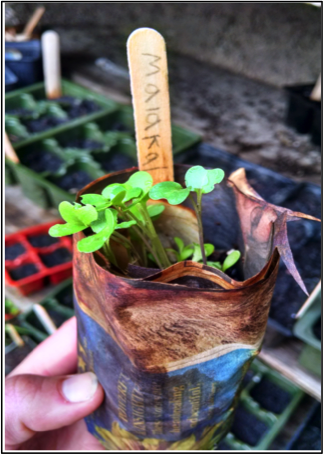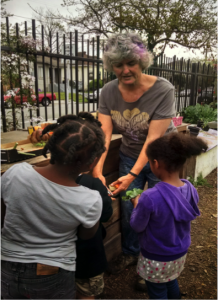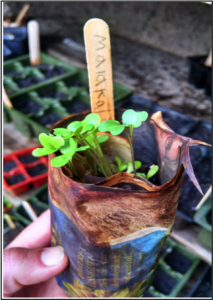Gavin Abreu, David Kagan, and Martha Lesniewski of project team Elementary Edible Education worked to help children develop healthy eating habits by teaching them where food comes through an edible education program.
It all started with a simple piece of Dinosaur Kale. Walking into the school garden at Malcolm X Elementary School, the Edible Education Team met Rivka Mason, the longtime garden coordinator and produce-advocate extraordinaire. For over fifteen years, Rivka has built and managed the school garden parked squarely in the middle of the school playground. With entrances on all sides, the students have the opportunity to run in and out during recess or any outside class time during the school day. All the plants in the garden can be picked and consumed on the spot, be it kale or sour sorrel, parsley or lettuce, mint or nasturtium. Rivka knows that children learn best by trying things for themselves.

Our Malcolm X ES student guide shows his completed “weedo” in front of the borage or happy flower plant
Visiting her renowned garden in March gave us a brief glimpse into the magical world that she has created for her students. Upon our arrival, she partnered us with two first-grade students to take us on a tour of the garden. Rivka recommended they teach us how to makes “Weedos”, a garden friendly version of a burrito made of only herbs and vegetables. We began our tour and Weedo-making process with a stop at the Dinosaur Kale plants; the giant leaves served as the ideal encasing for our festive entree. We slowly weaved through the garden, stopping to enjoy the scents of the different flowers and herbs and allowing us to become immersed in the experience. Our second stop was Italian Parsley, one of the world’s healthiest foods with a rich amount of B proteins and antioxidants. Our student as much goodness as we desired, not to mention munching on some on the side. Next stop was borage, an annual herb with bright purple flowers. Borage oil seed extracts have been traditionally used for a number of ailments including gastrointestinal disorders, arthritis and depression. As such, the students call borage flowers as “happy flowers” and eagerly pluck off the flowers. Continuing our tour, we filled our weedos with lettuce springs, sprouts, flowers and a wide array of herbs, totaling fifteen varieties of edible plants. When our project was complete, Rivka provided us a small piece of fresh fruit to help bring out the immense flavors. Our personalized weedos were delicious, and nutritious!
That afternoon in the school garden, we met a plethora of children who chose to spend their own recess time in the garden. Some students came to help mulch and harvest kale, while others came to pick off some leaves for an afternoon snack. Many were eager to share why they loved the school garden, “when we grow our food it tastes better”, and what foods they loved to eat, “ground cherries, heirloom fava beans, and peas.” Immersing in garden education has transformed the way these elementary school students view their food. When she first started the garden, Rivka recalls students stating that their food comes “from the basement of Safeway.” Through interesting lessons, fun games, and collective experiences, Rivka has made trying and eating vegetables fun, exciting and energizing. Today, there is no fighting to get the children to try something new – they do so with gusto because Rivka makes the experience memorable. It is not often that children demand such high quantities of sour sorrel that the supply simply cannot keep up.
Upon completing our tour, Rivka showed us the rest of the garden and the types of vegetables and plants she encourages children to take home. In a small shed that serves a greenhouse, Rivka has cups of soil and seedlings that students individually nurture and cultivate before taking home to plant. Students are trained on the soil, water and sun conditions each plant needs and Rivka makes herself available to answer any questions the students and their families may have both during and outside the school day. As Rivka enthusiastically states, “you can see the whole world in a seed.” Gardens teach patience and she encourages the students to take home and bring the garden experience out of the school garden and into their everyday lives. We left Rivka’s garden at Malcolm X Elementary School inspired and motivated by experiencing the joy and wonder of school gardens and witnessing a new generation of curious, connected and conscious students.
“One plant, one kid, you can change to world” – Rivka Mason



